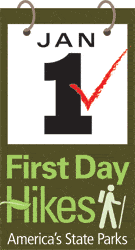First Day Hikes
 First Day Hikes are part of a nationwide initiative led by America’s State Parks to encourage people to get outdoors. On New Year’s Day, hundreds of free, guided hikes will be organized in all 50 states. Kids and adults all across America will be participating in First Day Hikes, getting their hearts pumping and enjoying the beauty of a state park. Last year nearly 55,000 people rang in the New Year, collectively hiking over 133,000 miles throughout the country!
First Day Hikes are part of a nationwide initiative led by America’s State Parks to encourage people to get outdoors. On New Year’s Day, hundreds of free, guided hikes will be organized in all 50 states. Kids and adults all across America will be participating in First Day Hikes, getting their hearts pumping and enjoying the beauty of a state park. Last year nearly 55,000 people rang in the New Year, collectively hiking over 133,000 miles throughout the country!
First Day Hikes are led by knowledgeable state park staff and volunteers. The distance and rigor vary from park to park, but all hikes aim to create a fun experience for the whole family. People are invited to savor the beauty of the state park’s natural resources with the comfort of an experienced guide so they may be inspired to take advantage of these local treasures throughout the year.
Find a First Day Hike near you
Cold Weather Hiking
Hiking during the winter can be fun as long as you prepare with these tips.
Dress in layers. While it is perhaps nice to have a huge, fluffy parka on the ski slopes, it really isn’t practical for the trail. Instead, take several layers you can peel off or put on when you stop and go on the trail. Your base layer should be a wicking fabric that will pull your sweat away from the skin. Overheating is a dangerous threat since excessive moisture that isn’t allowed to escape can freeze and cause hypothermia. If you ever wondered why some of your jackets have zippers under the armpits, it’s to keep air circulating and prevent your clothes from getting wet.
Wear a hat! Our heads are filled with oxygen-carrying capillaries which fuel our brains and consume one third of the body’s energy. During the colder months it is important to keep your head covered to maintain function and not lose precious body heat. You may want to bring a warmer/heavier hat for rest periods.
Keep your water bottle warm. Whether you are at the campsite or on the trail, a foam sleeve like a koozie will help prevent the water from freezing in a bottle. Nothing warms your body or your spirits like warm liquid by a campfire. Boil water to take with you as you hike. Also, to keep water from freezing, keep your water bottle on the inside of your jacket – properly sealed, of course.
Use a sleeping bag liner. You don’t have to bulk up with a heavier sleeping bag for winter camping. Putting a liner inside a 20 degree bag is an inexpensive way to boost your bag’s rating another 10 or so degrees.
Don’t toss the sunscreen. While this is most important if you are hiking in a snowy region, winter hikers often forget about the sun’s glare reflecting off of white snow.
Be prepared for shorter days. As early as October, dusk settles earlier and more quickly than in the summer. Have a good idea of the usable daylight hours before going hiking. Always carry a headlamp or flashlight with extra batteries.
In addition to these tips and hints, remember to follow normal safety practices as well when hiking in the winter. Be sure of the gear you take with you and if you have any specific questions, ask a local outdoor expert so you can stay safe.
America’s State Parks
America’s State Parks will help capture the collective strength and importance of the great park systems developed in the 50 states. With 10,234 units and more than 759 million visits, America’s State Parks works to enhance the American quality of life. NASPD board members representing each region of the country will govern the America’s State Parks alliance.

America’s State Parks + America’s National Parks = Great National System of Parks
Stephen T. Mather, founder of the National Park Service, envisioned that the states and the federal government needed to work together to develop a great national system of parks. By working together the nation would develop a national system of parks that would be the envy of the world.
Thanks to the vision of Stephen Mather and his contemporaries more than a billion visits a year are made to state and national parks (759 million state park visits and 307 million national park visits).
As Mather said, “Who will gain say that the parks contain the highest potentialities of national pride, national contentment, and national health? A visit inspires love of country; begets contentment; engenders pride of possession; contains the antidote for national restlessness…He is a better citizen with a keener appreciation of the privilege of living here who has toured the nations parks.”
| Total Park Visits: | More than 807 million per year |
| Number of state park units: | 8,565 |
| Total economic impact on communities: | More than $20 billion |
| Number of Trails | 14, 672 |
| Miles of trails: | 52,603 |
| Number of campsites: | 221,367 |
| Number of cabins and lodges: | 8,909 |
